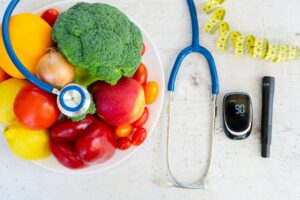Understanding food labels is a crucial skill for individuals managing diabetes. For many, these labels can appear as cryptic puzzles, but with a bit of guidance, you can decipher them to make informed dietary choices. This guide aims to shed light on the intricate components of food labels to help you better manage your diabetic condition.
Why Reading Food Labels Matters
For individuals with diabetes, monitoring carbohydrate intake is essential to maintain stable blood glucose levels. Unlike fats and proteins, carbohydrates have a direct impact on blood sugar levels. Thus, understanding the nutrient composition of the foods you consume becomes a cornerstone of effective diabetes management. Additionally, being aware of the fat, sodium, and fiber content in foods can help you maintain a balanced diet that supports overall health.
Key Components of Food Labels
Let’s break down the various elements you’ll encounter on a standard food label:
Serving Size
The serving size is the first piece of information you should pay attention to on a food label. All the nutritional information provided is based on this serving size. For example, if the serving size is one cup and you consume two cups, you’ll need to double all the nutritional values listed.
Total Carbohydrates
Among the most critical elements for anyone managing diabetes, the ‘Total Carbohydrates’ section usually encompasses three parts:
- Dietary Fiber: Fiber is a carbohydrate that your body doesn’t digest. It helps regulate the body’s use of sugars, maintaining hunger and blood sugar levels in check. A higher fiber content is advantageous as it slows down the absorption of sugars.
- Total Sugars: Includes both natural sugars (like those found in fruit) and added sugars. It’s usually beneficial to minimize foods high in added sugars. The American Heart Association recommends limiting added sugars to no more than 25 grams (or about 6 teaspoons) per day for women and 36 grams (or about 9 teaspoons) per day for men.
- Added Sugars: This is a subset of Total Sugars and includes sugars that are added during processing. Keeping an eye on this helps you select foods with minimal added sugars.
Net Carbs
Net Carbs are an essential concept for people with diabetes. They are calculated by subtracting dietary fiber and sugar alcohols (if listed) from the total carbohydrates. The idea is that fiber and sugar alcohols do not raise blood sugar levels significantly. Always consult your healthcare provider to understand how to best use net carbs in your dietary planning.
Fats
While carbohydrates are often the main focus, fats also play a role in diabetes management. Here are the types of fats you’ll find listed:
- Total Fat: Reflects all the fat in one serving of the product.
- Saturated Fat: Usually solid at room temperature and found in animal products and some plant oils. High intakes can raise blood cholesterol levels, so it’s best to limit these fats.
- Trans Fat: Mainly found in processed foods, these fats can increase the risk of heart disease and should be avoided as much as possible.
Sodium
While sodium does not directly affect blood glucose levels, it can impact cardiovascular health and blood pressure, both of which are vital considerations for people with diabetes. The American Diabetes Association recommends consuming less than 2,300 mg of sodium per day.
How to Read Ingredients Lists
The ingredients list, usually beneath the nutrition facts, lists every ingredient in the product in descending order by weight. Here are tips for reading the ingredients list effectively:
- Look for whole foods: Ingredients like whole grains, vegetables, and lean proteins are generally better choices.
- Avoid artificial additives: Try to steer clear of products with long lists of ingredients, especially those with names that are hard to pronounce.
- Identify hidden sugars: Sugars can be listed under various names like sucrose, high fructose corn syrup, honey, and agave nectar. Recognizing these can help you make smarter choices.
Practical Tips for Grocery Shopping
Managing diabetes isn’t just about reading labels, but also making the right choices in the grocery store. Here’s how:
- Stick to the perimeter: Most grocery stores stock fresh produce, meats, and dairy products along the outer aisles. These sections generally offer healthier options.
- Plan your meals: Having a grocery list that aligns with your dietary needs can help prevent impulse buys.
- Be cautious of marketing claims: Terms like “low fat,” “sugar-free,” or “all-natural” can be misleading. Always verify these claims by checking the label.
Dining Out
Eating out can be challenging, but with a few strategies, you can make healthier choices:
- Do your research: Many restaurants provide nutritional information on their websites. Review these details beforehand to make an informed decision.
- Ask for modifications: Don’t hesitate to ask for dressings on the side, grilled options instead of fried, or extra vegetables instead of bread.
- Practice portion control: Restaurant servings are often larger than necessary. Consider sharing a meal or taking half of it to go.
Meal Planning and Home Cooking
Planning meals and cooking at home allows you to have complete control over what goes into your food. Here are some tips to help you get started:
- Use reliable resources: Many cookbooks and online resources offer diabetic-friendly recipes, complete with nutritional information.
- Batch cook: Preparing meals in bulk can save time and ensure you always have a healthy option available.
- Balance your plate: Aim for a balance of vegetables, lean proteins, and whole grains. Using the “plate method” (filling half your plate with non-starchy vegetables, a quarter with lean protein, and the remaining quarter with whole grains or starchy vegetables) can be a helpful guideline.
Consulting Healthcare Providers
Lastly, always consult healthcare professionals, like a registered dietitian or your endocrinologist, for personalized advice tailored to your specific condition. They can offer insights into how different foods affect your blood sugar levels and guide you on making the best dietary choices.
Ultimately, understanding food labels is a crucial skill for managing diabetes effectively. By paying attention to serving sizes, total carbohydrates, fats, sodium, and identifying added sugars and fiber, you can make smarter, healthier choices that support your overall well-being. Remember, the key to successful diabetes management lies in consistent monitoring, informed choices, and ongoing consultation with healthcare providers.




